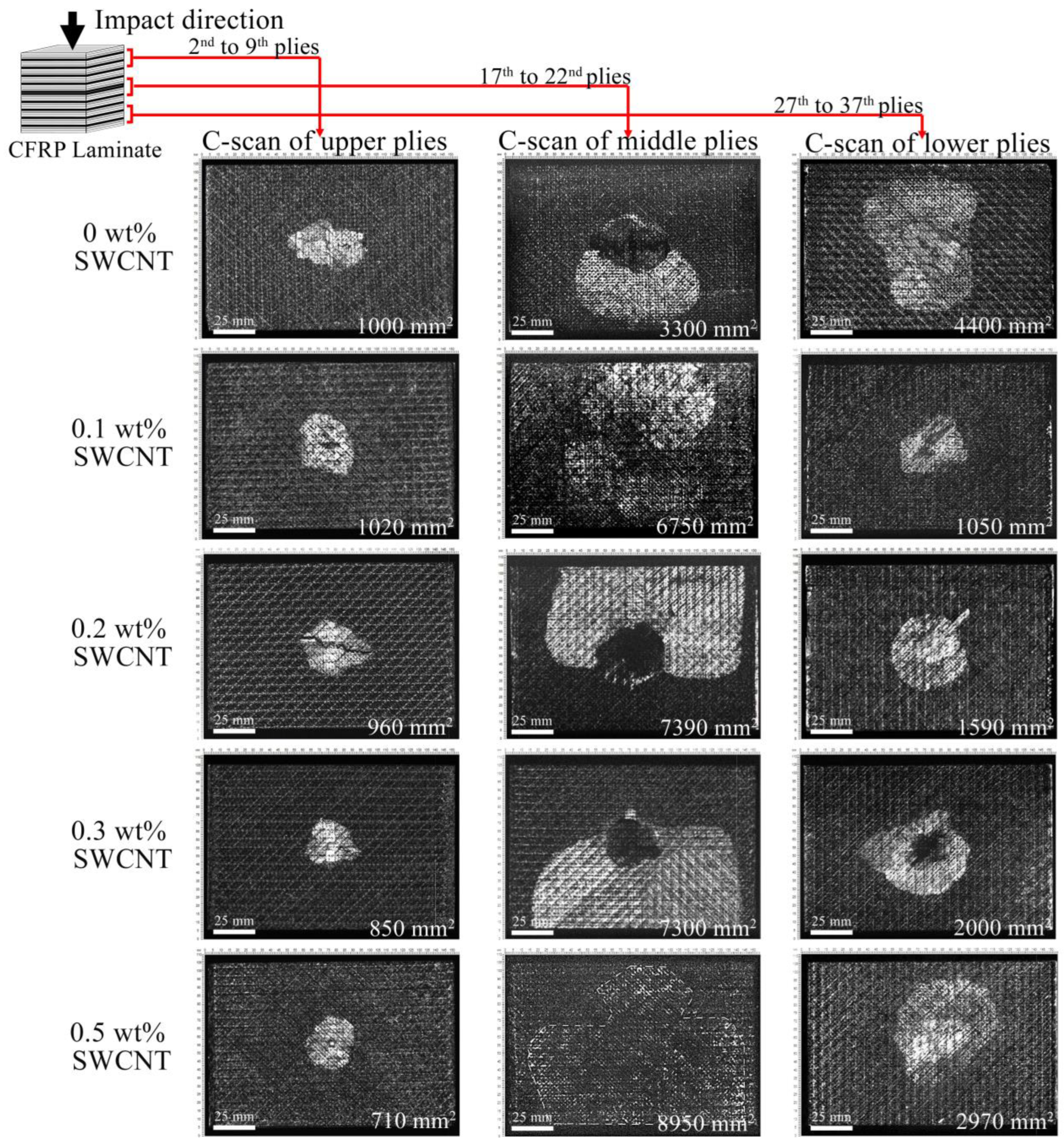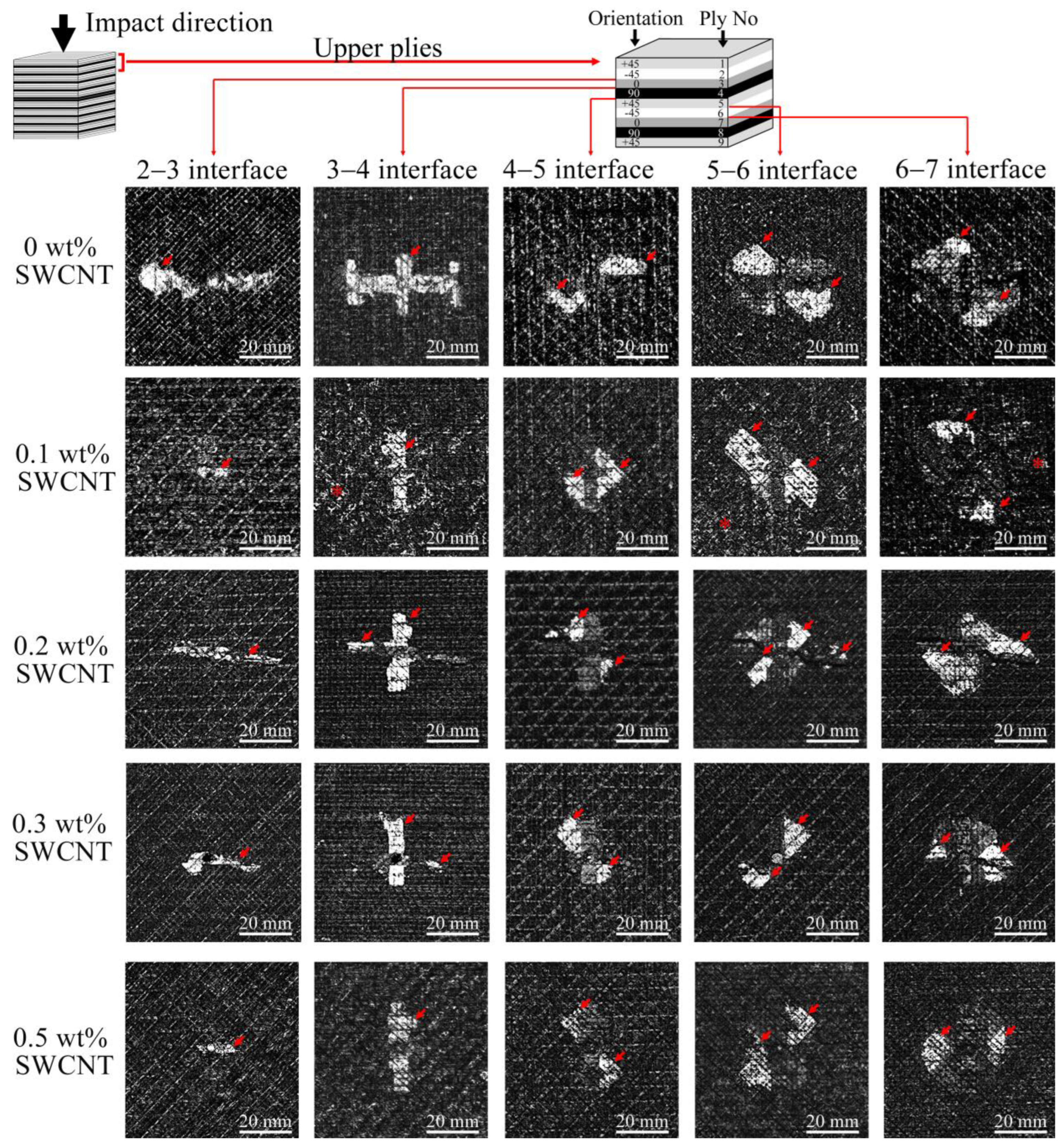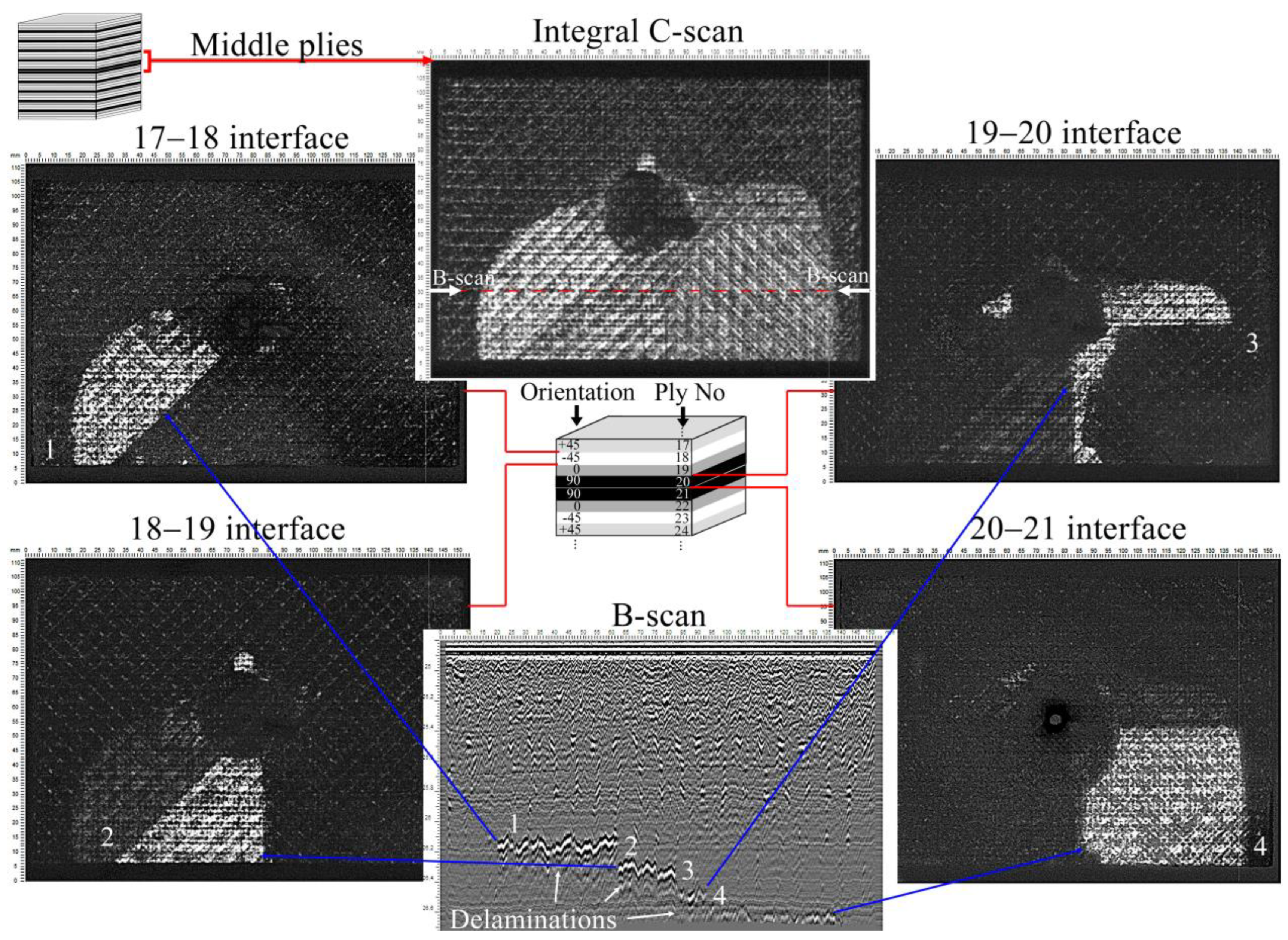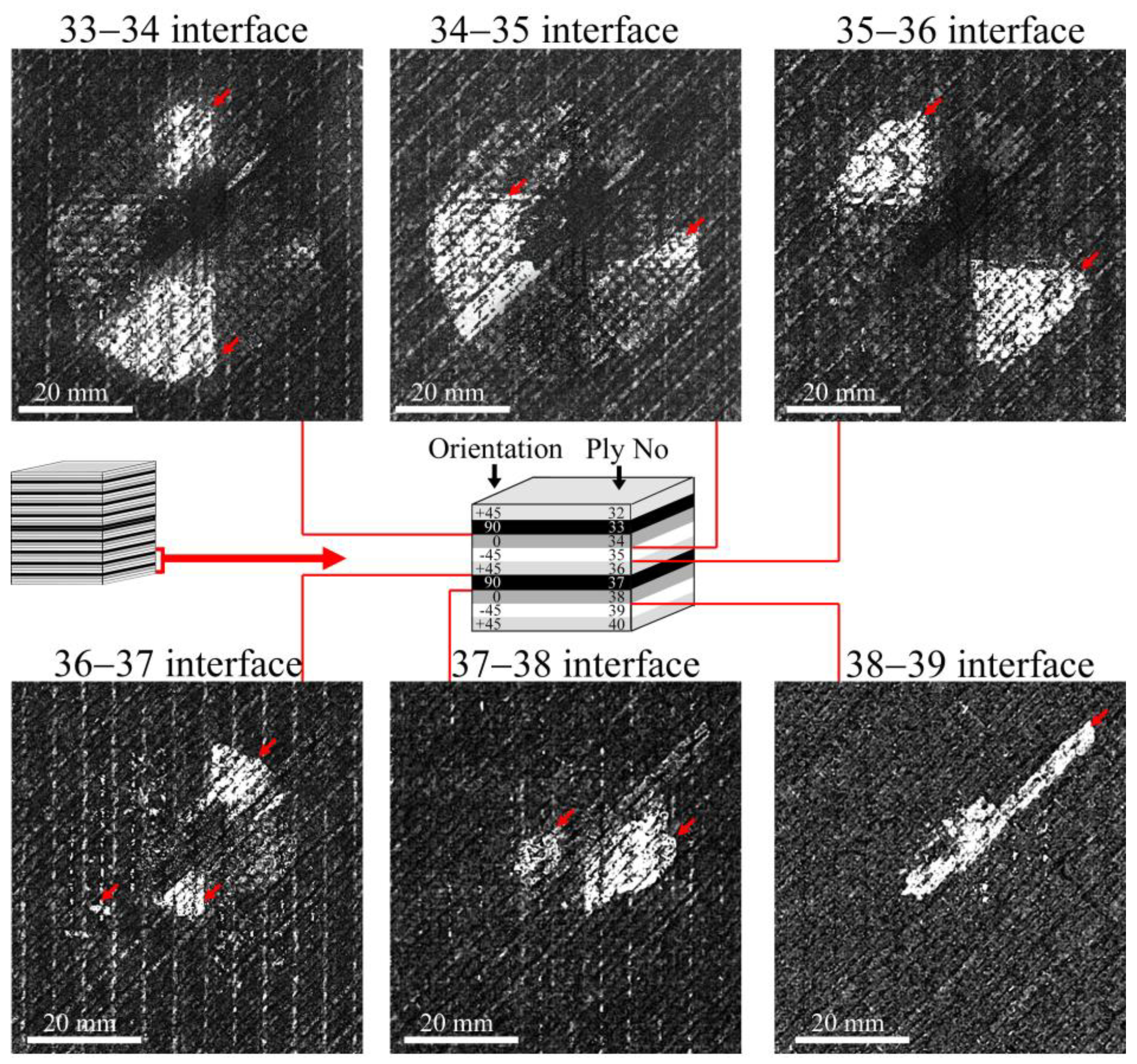Influence of CNT Filler in Polymer Matrix on Impact Damage Propagation in the Volume of Carbon Fiber Laminates
Abstract
1. Introduction
2. Materials and Methods
2.1. Specimen Preparation
2.2. Scanning Electron Microscopy
2.3. Mechanical Tests
2.4. High-Resolution Ultrasound Imaging
3. Results
3.1. SEM Investigations
3.2. Impact Behavior
3.3. Projected Damaged Areas of the Laminates
3.4. Layer-by-Layer Imaging of Damage of the Laminates
4. Discussion
5. Conclusions
- −
- The addition of CNTs to the matrix reduces the damaged areas in the outer plies of the laminates; the size of damages was two times smaller compared to damage in a laminate without CNTs.
- −
- Increasing the concentration of CNTs increases interlayer interaction and impact energy transfer through the thickness, which affects the energy absorption in laminates and increases damage in the middle region.
- −
- CNT conglomeration affects the stress distribution in laminates, which reduces the threshold load for delamination.
Author Contributions
Funding
Institutional Review Board Statement
Data Availability Statement
Acknowledgments
Conflicts of Interest
Abbreviations
| CFRP | Carbon fiber reinforced polymer |
| CNT | Carbon nanotube |
References
- Xu, X.; Peng, G.; Zhang, B.; Shi, F.; Gao, L.; Gao, J. Material Performance, Manufacturing Methods, and Engineering Applications in Aviation of Carbon Fiber Reinforced Polymers: A Comprehensive Review. Thin-Walled Struct. 2025, 209, 112899. [Google Scholar] [CrossRef]
- Harussani, M.M.; Sapuan, S.M.; Nadeem, G.; Rafin, T.; Kirubaanand, W. Recent Applications of Carbon-Based Composites in Defence Industry: A Review. Def. Technol. 2022, 18, 1281–1300. [Google Scholar] [CrossRef]
- Alshehri, A.H.; Alamry, A.; Koloor, S.S.R.; Alzahrani, B.; Arockiarajan, A. Investigating Low Velocity Impact and Compression after Impact Behaviors of Carbon Fiber/Epoxy Composites Reinforced with Helical Multiwalled Carbon Nanotubes. J. Eng. Res. 2024, in press. [Google Scholar] [CrossRef]
- Sergi, C.; Ierardo, N.; Lampani, L.; Calzolari, A.; Valente, T.; Sarasini, F.; Tirillò, J. Low-Velocity Impact Response of MWCNTs Toughened CFRP Composites: Stacking Sequence and Temperature Effects. Thin-Walled Struct. 2022, 175, 109182. [Google Scholar] [CrossRef]
- Kennedy, S.M.; Vasanthanathan, A.; Jeen Robert, R.B.; Amudhan, K.; Nagendran, M. Impact of Fillers in Enhancing the Properties of CFRP Composites—A Comprehensive Exploration. Next Res. 2025, 2, 100117. [Google Scholar] [CrossRef]
- Sharma, S.P.; Lakkad, S.C. Comparative Study of the Effect of Fiber Surface Treatments on the Flexural and Interlaminar Shear Strength of Carbon Fiber-Reinforced Composites. Mater. Today Commun. 2020, 24, 101016. [Google Scholar] [CrossRef]
- Atmakuri, A.; Palevicius, A.; Vilkauskas, A.; Janusas, G. Review of Hybrid Fiber Based Composites with Nano Particles-Material Properties and Applications. Polymers 2020, 12, 2088. [Google Scholar] [CrossRef]
- Javanshour, F.; Prapavesis, A.; Lahtonen, K.; Pournoori, N.; Pärnänen, T.; Kanerva, M.; Van Vuure, A.W.; Sarlin, E. Effect of Graphene Oxide Fibre Surface Modification on Low-Velocity Impact and Fatigue Performance of Flax Fibre Reinforced Composites. Compos. Part C Open Access 2023, 11, 100360. [Google Scholar] [CrossRef]
- Dalfi, H.K.; Jan, K.; Yousaf, Z.; Peerzada, M. Improving the Impact Resistance and Damage Tolerance of Fibre Reinforced Composites: A Review. J. Compos. Mater. 2023, 57, 4479–4500. [Google Scholar] [CrossRef]
- Jen, Y.M.; Chen, Y.J.; Yu, T.H. Improving the Impact Resistance and Post-Impact Tensile Fatigue Damage Tolerance of Carbon Fiber Reinforced Epoxy Composites by Embedding the Carbon Nanoparticles in Matrix. Polymers 2024, 16, 3589. [Google Scholar] [CrossRef]
- Bedsole, R.W.; Bogert, P.B.; Tippur, H.V. An Experimental Investigation of Interlaminar and Intralaminar Dynamic Fracture of CFRPs: Effect of Matrix Modification Using Carbon Nanotubes. Compos. Struct. 2015, 132, 1043–1055. [Google Scholar] [CrossRef]
- Hosseini, M.; Gaff, M.; Li, H.; Konvalinka, P.; Lair, J.; Hui, D.; Ghosh, P.; Hosseini, A.; Gaur, P.; Lorenzo, R.; et al. A Review of the Performance of Fibre-Reinforced Composite Laminates with Carbon Nanotubes. Nanotechnol. Rev. 2023, 12, 20230164. [Google Scholar] [CrossRef]
- Ou, Y.; González, C.; Vilatela, J.J. Interlaminar Toughening in Structural Carbon Fiber/Epoxy Composites Interleaved with Carbon Nanotube Veils. Compos. Part A Appl. Sci. Manuf. 2019, 124, 105477. [Google Scholar] [CrossRef]
- Meireman, T.; Verboven, E.; Kersemans, M.; Van Paepegem, W.; De Clerck, K.; Daelemans, L. Low-Velocity Impact Resistance and Compression After Impact Strength of Thermoplastic Nanofiber Toughened Carbon/Epoxy Composites with Different Layups. Polymers 2024, 16, 3060. [Google Scholar] [CrossRef]
- Zhang, X.; Sun, T.; Qiu, B.; Liang, M.; Zou, H. Investigation on Interlaminar Behavior of Different Morphology GO Structured Carbon Fiber Reinforced Epoxy Composites. Compos. Part B Eng. 2022, 230, 109492. [Google Scholar] [CrossRef]
- Du, X.; Zhou, H.; Sun, W.; Liu, H.Y.; Zhou, G.; Zhou, H.; Mai, Y.W. Graphene/Epoxy Interleaves for Delamination Toughening and Monitoring of Crack Damage in Carbon Fibre/Epoxy Composite Laminates. Compos. Sci. Technol. 2017, 140, 123–133. [Google Scholar] [CrossRef]
- Zakaria, M.R.; Abdul Kudus, M.H.; Akil, H.M.; Mohd Thirmizir, M.Z. Comparative Study of Graphene Nanoparticle and Multiwall Carbon Nanotube Filled Epoxy Nanocomposites Based on Mechanical, Thermal and Dielectric Properties. Compos. Part B Eng. 2017, 119, 57–66. [Google Scholar] [CrossRef]
- Chowdhury, F.H.; Hosur, M.V.; Jeelani, S. Processing, Impact Response and Damage Characterisation of Plain-Weave Carbon/Epoxy-Nanoclay Nanocomposites. Polym. Polym. Compos. 2007, 15, 425–435. [Google Scholar] [CrossRef]
- Agnihotri, S.N.; Thakur, R.K.; Singh, K.K. Influence of Nanoclay Filler on Mechanical Properties of CFRP Composites. Mater. Today Proc. 2022, 66, 1734–1738. [Google Scholar] [CrossRef]
- Wang, Y.; Liu, X.; Chen, L.; Shen, W.; Zhu, L. Simultaneously Improve the Mode II Interlaminar Fracture Toughness, Flexural Properties, and Impact Strength of CFRP Composites with Short Aramid Fiber Interlaminar Toughening. Polym. Compos. 2022, 43, 8437–8442. [Google Scholar] [CrossRef]
- Liu, Y.; Zou, A.; Wang, G.; Han, C.; Blackie, E. Enhancing Interlaminar Fracture Toughness of CFRP Laminates with Hybrid Carbon Nanotube/Graphene Oxide Fillers. Diam. Relat. Mater. 2022, 128, 109285. [Google Scholar] [CrossRef]
- Kostagiannakopoulou, C.; Tsilimigkra, X.; Sotiriadis, G.; Kostopoulos, V. Synergy Effect of Carbon Nano-Fillers on the Fracture Toughness of Structural Composites. Compos. Part B Eng. 2017, 129, 18–25. [Google Scholar] [CrossRef]
- Koirala, P.; van de Werken, N.; Lu, H.; Baughman, R.H.; Ovalle-Robles, R.; Tehrani, M. Using Ultra-Thin Interlaminar Carbon Nanotube Sheets to Enhance the Mechanical and Electrical Properties of Carbon Fiber Reinforced Polymer Composites. Compos. Part B Eng. 2021, 216, 108842. [Google Scholar] [CrossRef]
- Tehrani, M.; Boroujeni, A.Y.; Hartman, T.B.; Haugh, T.P.; Case, S.W.; Al-Haik, M.S. Mechanical Characterization and Impact Damage Assessment of a Woven Carbon Fiber Reinforced Carbon Nanotube-Epoxy Composite. Compos. Sci. Technol. 2013, 75, 42–48. [Google Scholar] [CrossRef]
- Mousavi, S.R.; Estaji, S.; Paydayesh, A.; Arjmand, M.; Jafari, S.H.; Nouranian, S.; Khonakdar, H.A. A Review of Recent Progress in Improving the Fracture Toughness of Epoxy-Based Composites Using Carbonaceous Nanofillers. Polym. Compos. 2022, 43, 1871–1886. [Google Scholar]
- Tan, K.T.; Watanabe, N.; Iwahori, Y. X-Ray Radiography and Micro-Computed Tomography Examination of Damage Characteristics in Stitched Composites Subjected to Impact Loading. Compos. Part B Eng. 2011, 42, 874–884. [Google Scholar] [CrossRef]
- Léonard, F.; Stein, J.; Soutis, C.; Withers, P.J. The Quantification of Impact Damage Distribution in Composite Laminates by Analysis of X-Ray Computed Tomograms. Compos. Sci. Technol. 2017, 152, 139–148. [Google Scholar] [CrossRef]
- Gao, Y.; Hu, W.; Xin, S.; Sun, L. A Review of Applications of CT Imaging on Fiber Reinforced Composites. J. Compos. Mater. 2022, 56, 133–164. [Google Scholar] [CrossRef]
- Yudhanto, A.; Lubineau, G. X-Ray Computed Tomography for Assessing Impact Damage in Composites. In Non-Destructive Testing of Impact Damage in Fiber-Reinforced Polymer Composites; Elsevier: Amsterdam, The Netherlands, 2024; pp. 187–213. [Google Scholar] [CrossRef]
- Morokov, E.; Levin, V.; Chernov, A.; Shanygin, A. High Resolution Ply-by-Ply Ultrasound Imaging of Impact Damage in Thick CFRP Laminates by High-Frequency Acoustic Microscopy. Compos. Struct. 2021, 256, 113102. [Google Scholar] [CrossRef]
- Yang, X.; Ju, B.F.; Kersemans, M. Assessment of the 3D Ply-by-Ply Fiber Structure in Impacted CFRP by Means of Planar Ultrasound Computed Tomography (PU-CT). Compos. Struct. 2022, 279, 114745. [Google Scholar] [CrossRef]
- Lan, Z.; Saito, O.; Yu, F.; Okabe, Y. Impact Damage Detection in Woven CFRP Laminates Based on a Local Defect Resonance Technique with Laser Ultrasonics. Mech. Syst. Signal Process. 2024, 207, 110929. [Google Scholar] [CrossRef]
- Yu, Z.; Chen, J.; Wu, S.; Xie, Y.; Wu, H.; Wang, H.; Peng, H.X. Adaptive Ultrasonic Full-Matrix Imaging of Internal Defects in CFRP Laminates with Arbitrary Stacking Sequences. Compos. Part B Eng. 2024, 275, 111309. [Google Scholar] [CrossRef]
- Poelman, G.; Hedayatrasa, S.; Van Paepegem, W.; Kersemans, M. Enhanced Thermographic Inspection of Woven Fabric Composites by K-Space Filtering. Compos. Part B Eng. 2023, 252, 110508. [Google Scholar] [CrossRef]
- Gerdes, L.; Walther, F. Impact Damage Detection for Carbon Fiber-Reinforced Polyurethane by Means of Active Thermography and Computed Tomography. Eng. Fail. Anal. 2025, 170, 109306. [Google Scholar] [CrossRef]
- Xiao, S.; Chen, P.; Ye, Q. Prediction of Damage Area in Laminated Composite Plates Subjected to Low Velocity Impact. Compos. Sci. Technol. 2014, 98, 51–56. [Google Scholar] [CrossRef]
- Bogenfeld, R.; Kreikemeier, J.; Wille, T. Review and Benchmark Study on the Analysis of Low-Velocity Impact on Composite Laminates. Eng. Fail. Anal. 2018, 86, 72–99. [Google Scholar] [CrossRef]
- Falcó, O.; Lopes, C.S.; Sommer, D.E.; Thomson, D.; Ávila, R.L.; Tijs, B.H.A.H. Experimental Analysis and Simulation of Low-Velocity Impact Damage of Composite Laminates. Compos. Struct. 2022, 287, 115278. [Google Scholar] [CrossRef]
- Zhang, J.; Xie, J.; Zhao, X.; Chen, J.; Li, Z. Influence of Void Defects on Impact Properties of CFRP Laminates Based on Multi-Scale Simulation Method. Int. J. Impact Eng. 2023, 180, 104706. [Google Scholar] [CrossRef]
- Turbin, N.; Shelkov, K. Analysis Method for Post-Impact Damage Development in Carbon Fiber Reinforced Laminate under Repeated Loading. J. Compos. Sci. 2023, 7, 201. [Google Scholar] [CrossRef]
- Bolshikh, A.; Shelkov, K.; Borovkov, D.; Turbin, N. Comparative Evaluation of Mathematical Models of Polymer Composite Material with the Implementation of a Three-Dimensional Stress–Strain State in the Simulation of Impact. Aerosp. Syst. 2024. [Google Scholar] [CrossRef]
- Shabani, P.; Li, L.; Laliberte, J.; Qi, G. Compression after Impact (CAI) Failure Mechanisms and Damage Evolution in Large Composite Laminates: High-Fidelity Simulation and Experimental Study. Compos. Struct. 2024, 339, 118143. [Google Scholar] [CrossRef]
- ASTM D7136/D7136M-15; Standard Test Method for Measuring the Damage Resistance of a Fiber-Reinforced Polymer Matrix Composite to a Drop-Weight Impact Event. ASTM: West Conshohocken, PA, USA, 2020.
- Morokov, E.; Levin, V.; Ryzhova, T.; Dubovikov, E.; Petronyuk, Y.; Gulevsky, I. Bending Damage Evolution from Micro to Macro Level in CFRP Laminates Studied by High-Frequency Acoustic Microscopy and Acoustic Emission. Compos. Struct. 2022, 288, 115427. [Google Scholar] [CrossRef]
- Morokov, E.; Titov, S.; Levin, V. In Situ High-Resolution Ultrasonic Visualization of Damage Evolution in the Volume of Quasi-Isotropic CFRP Laminates under Tension. Compos. Part B Eng. 2022, 247, 110360. [Google Scholar] [CrossRef]
- Karthikeyan, N.; Naveen, J.; Rajesh, M.; Reddy, D.M.; Sudhagar, P.; Norrrahim, M.; Knight, V. Flexural and vibration behaviours of novel covered CFRP composite joints with an MWCNT-modified adhesive. Nanotechnol. Rev. 2024, 13, 20240076. [Google Scholar] [CrossRef]
- Zeng, L.; Tao, W.; Zhao, J.; Li, Y.; Li, R. Mechanical performance of a CFRP composite reinforced via gelatin-CNTs: A study on fiber interfacial enhancement and matrix enhancement. Nanotechnol. Rev. 2022, 11, 625–636. [Google Scholar] [CrossRef]
- Li, J.; Zhang, Z.; Fu, J.; Liang, Z.; Ramakrishnan, K. Mechanical properties and structural health monitoring performance of carbon nanotube-modified FRP composites: A review. Nanotechnol. Rev. 2021, 10, 1438–1468. [Google Scholar] [CrossRef]
- Cong, F.; Zhang, R.; Li, W.; Jin, Y.; Yu, G.; Wu, L. Buckling analysis of moderately thick carbon fiber composite cylindrical shells under hydrostatic pressure. Appl. Ocean. Res. 2024, 153, 104272. [Google Scholar] [CrossRef]







| Specimen | 0 wt% | 0.1 wt% | 0.2 wt% | 0.3 wt% | 0.5 wt% |
|---|---|---|---|---|---|
| Threshold load Fd, kN | 4.25 | 3.90 | 4.44 | 4.55 | 3.40 |
| Peak force Fmax, kN | 11.80 | 11.68 | 11.84 | 10.80 | 11.42 |
| Initiation Energy Eini, J | 2.10 | 1.70 | 2.70 | 2.80 | 1.80 |
| Energy to peak force Emax, J | 29.73 | 27.62 | 27.98 | 23.22 | 27.85 |
| Absorbed Energy Eab, J | 13.50 | 15.50 | 17.30 | 16.40 | 18.20 |
Disclaimer/Publisher’s Note: The statements, opinions and data contained in all publications are solely those of the individual author(s) and contributor(s) and not of MDPI and/or the editor(s). MDPI and/or the editor(s) disclaim responsibility for any injury to people or property resulting from any ideas, methods, instructions or products referred to in the content. |
© 2025 by the authors. Licensee MDPI, Basel, Switzerland. This article is an open access article distributed under the terms and conditions of the Creative Commons Attribution (CC BY) license (https://creativecommons.org/licenses/by/4.0/).
Share and Cite
Morokov, E.; Shershak, P.; Burkov, M.; Eremin, A.; Popkova, E.; Yakovlev, N.; Zhiltsova, I. Influence of CNT Filler in Polymer Matrix on Impact Damage Propagation in the Volume of Carbon Fiber Laminates. Polymers 2025, 17, 891. https://doi.org/10.3390/polym17070891
Morokov E, Shershak P, Burkov M, Eremin A, Popkova E, Yakovlev N, Zhiltsova I. Influence of CNT Filler in Polymer Matrix on Impact Damage Propagation in the Volume of Carbon Fiber Laminates. Polymers. 2025; 17(7):891. https://doi.org/10.3390/polym17070891
Chicago/Turabian StyleMorokov, Egor, Pavel Shershak, Mikhail Burkov, Alexander Eremin, Elizaveta Popkova, Nikolay Yakovlev, and Irina Zhiltsova. 2025. "Influence of CNT Filler in Polymer Matrix on Impact Damage Propagation in the Volume of Carbon Fiber Laminates" Polymers 17, no. 7: 891. https://doi.org/10.3390/polym17070891
APA StyleMorokov, E., Shershak, P., Burkov, M., Eremin, A., Popkova, E., Yakovlev, N., & Zhiltsova, I. (2025). Influence of CNT Filler in Polymer Matrix on Impact Damage Propagation in the Volume of Carbon Fiber Laminates. Polymers, 17(7), 891. https://doi.org/10.3390/polym17070891





